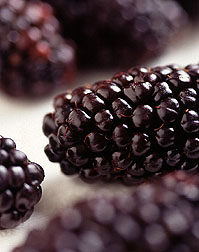This page has been archived and is being provided for reference purposes only. The page is no longer being updated, and therefore, links on the page may be invalid.
Managing Rosette in Blackberries Helps Small FarmersBy Tara Weaver-MissickDecember 3, 1999 New strategies for controlling rosette disease in blackberries could open a new fruit market for small farmers. Rosette, or double blossom, is one of the most severe fungal diseases of blackberries grown in the southeastern United States. Many crops fall prey to this disease, which reduces yields and fruit quality. Plant pathologist Barbara J. Smith has found a way to control the disease using a modified fungicide spray schedule. Smith is with the Agricultural Research Service’s Small Fruit Research Station in Poplarville, Miss. ARS is the U.S. Department of Agriculture’s chief scientific research agency To control rosette, growers have been using information from the 1930s. This information is outdated, since new cultivars have been developed and the disease itself has changed since then. Smith has found the most effective way to control rosette is to apply four fungicide applications at a 10-14 day interval beginning about six weeks before berries ripen and continuing until three days before harvest. She also recommends a fifth application immediately after harvest. Many farmers have been disappointed with fungicidal control of rosette, because they thought spraying would control the disease in that year’s crop. But that’s not the case; fungicides applied this year help control next year’s rosette problem. The most effective fungicide tested for controlling rosette, caused by the fungus Cercosporella rubi, is benomyl. Few fungicides are registered and available for controlling blackberry diseases. Smith plans to evaluate some new fungicides and is also looking more closely at the pathogen and how it infects the fruit. Rosette disease is one of the major reasons southeastern farmers don’t grow this specialty crop, which could yield $3,000 to $4,000 an acre. Overcoming this disease offers a high- value crop that costs less to establish than strawberries and blueberries. Scientific contact: Barbara J. Smith, ARS Small Fruit Research Station, Poplarville, Miss., phone (601) 795-8751, fax (601) 795-4965. |

